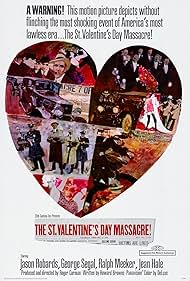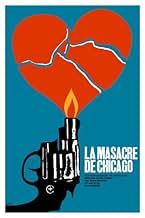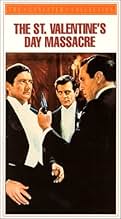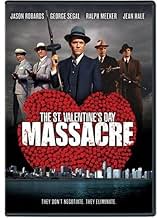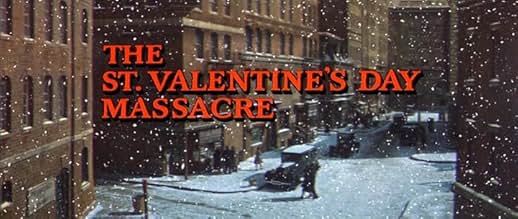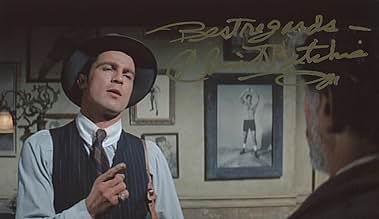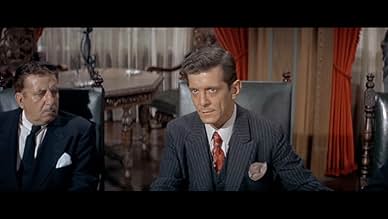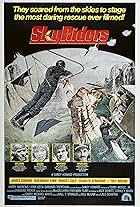IMDb RATING
6.6/10
4.9K
YOUR RATING
Al Capone's Valentine's Day surprise for the rival Bugs Moran gang in 1929 Chicago.Al Capone's Valentine's Day surprise for the rival Bugs Moran gang in 1929 Chicago.Al Capone's Valentine's Day surprise for the rival Bugs Moran gang in 1929 Chicago.
Joe Turkel
- Jake 'Greasy Thumb' Guzik
- (as Joseph Turkel)
- Director
- Writer
- All cast & crew
- Production, box office & more at IMDbPro
Storyline
Did you know
- TriviaFor the massacre scene in the garage, the actors playing the slain gangsters were shown photos and directed as how to fall so their positions were identical to the real photos of the massacre. Two actors bumped together on the way down. After studying photographs they realized they had fallen and collided in the exact way the slain gangsters had fallen and had landed in the correct positions.
- Quotes
Reporter: Y'know some are sayin' that it really was the cops who shot those men.
Bugs Moran: You must be new to this town, mister. Only Al Capone kills like that.
- ConnectionsEdited into Capone (1975)
Featured review
It's incredible to think that this film, Roger Corman's major studio debut, and THE GODFATHER (made by Corman alumnus Coppola) were made within five years of each other. They could be decades apart, in look, in sensibility, in impact. Whereas GODFATHER gropes for a rich, mythic timelessness, MASSACRE seems brittle, thin, a mere pastiche of, variously, 30s Warners gangster films, 40s B-movies, or Corman's own early work. Whereas Coppola's characters have passed into popular culture, Corman's gangsters are thinly characterised, theatrical, parodic; whereas GODFATHER's plot is slow-burning, tense, silent, punctuated with shocking shards of tangible violence, MASSACRE is almost cartoon-like in its relentless gunfire, which, because it's not rooted in character, does not have as traumatic an effect.
Some of us, however, might recoil a little from the major film's more questionable posturing, and MASSACRE has many excellencies. Most immediately pleasurable is the plot, mathematically simple, as Corman narrates the titular bloodbath like a theorem, showing A (Capone) meeting B (Moran) to create C (the massacre). QED. Nothing is allowed interfere with this beautiful simplicity - every scene, every character, every action refers to this theorem alone. Even scenes which seem to illustrate character (eg Peter Gusenberg and Myrtle) only do so to 'explain' why one side got the better of another.
This quality extends to the film as a whole, which is a series of repetitions and mirroring scenes. Another pleasure is the voiceover, which again transforms a conventional narrative about real people into abstract formalism. Like a voice of God, it intrudes without warning, frequently, mixing bald factual details about all the players (eg Such and such, born 1893 in such a place, suspected gun-runner, killer etc., will die on 3 May 1957 of heart failure) with speculation. Before any character has even begun their parts in the film, their life stories are known to us. This robs them of everything that makes us human - motivation, hope, action. Sartre said we are what we do. Not here. Robbed of human characteristics, they become mere ciphers, playing out their inevitable fates, and denying the viewer the kind of emotional empathy that Coppola will dubiously over-indulge in.
Despite the (relatively) high budget, production values do nothing to make the film more realistic. Indeed, the uniformity of colour (predominantly grey), the repetition of scenes and places, the reduction of sequences to sheer functionality, makes the film increasingly artificial. The theatricality of the acting adds to this, with Robards especially hamming away to amusingly grand effect, but theatricality is embedded too, as narratively crucial scenes become sites for rhetoric, oratory, dramatic performance, an actor declaiming to an enrapt public, hanging (for dear life) to his every word.
Add to all this Corman's stunning, playful direction, confident and fluid, making interiors and objects live, fixing characters in their place. The violent scenes are expertly choreographed, if they aren't disturbing, their formal excellence is undiminished. All this formalism is not an empty, academic exercise. By revealing the phoniness of his subject matter, Corman reveals the processes of myth-making that, especially through the cinema, curiously glamourised an era, when America was in thrall to a number of violent fascists.
Corman is not seriously moralistic, he is cheerfully aware of human nature's strange pulls - he shows how the need for violence and sensation in cinema is close to the fascistic, but also undeniable. It is a trap Coppola doesn't always avoid. The score, which makes ragtime eerily modernist, is astounding, while Corman reveals, as in TALES OF TERROR, that he has a canny sense of the domestic's comic violence - the Pete/Myrtle scene is a hilarious-troubling classic.
Some of us, however, might recoil a little from the major film's more questionable posturing, and MASSACRE has many excellencies. Most immediately pleasurable is the plot, mathematically simple, as Corman narrates the titular bloodbath like a theorem, showing A (Capone) meeting B (Moran) to create C (the massacre). QED. Nothing is allowed interfere with this beautiful simplicity - every scene, every character, every action refers to this theorem alone. Even scenes which seem to illustrate character (eg Peter Gusenberg and Myrtle) only do so to 'explain' why one side got the better of another.
This quality extends to the film as a whole, which is a series of repetitions and mirroring scenes. Another pleasure is the voiceover, which again transforms a conventional narrative about real people into abstract formalism. Like a voice of God, it intrudes without warning, frequently, mixing bald factual details about all the players (eg Such and such, born 1893 in such a place, suspected gun-runner, killer etc., will die on 3 May 1957 of heart failure) with speculation. Before any character has even begun their parts in the film, their life stories are known to us. This robs them of everything that makes us human - motivation, hope, action. Sartre said we are what we do. Not here. Robbed of human characteristics, they become mere ciphers, playing out their inevitable fates, and denying the viewer the kind of emotional empathy that Coppola will dubiously over-indulge in.
Despite the (relatively) high budget, production values do nothing to make the film more realistic. Indeed, the uniformity of colour (predominantly grey), the repetition of scenes and places, the reduction of sequences to sheer functionality, makes the film increasingly artificial. The theatricality of the acting adds to this, with Robards especially hamming away to amusingly grand effect, but theatricality is embedded too, as narratively crucial scenes become sites for rhetoric, oratory, dramatic performance, an actor declaiming to an enrapt public, hanging (for dear life) to his every word.
Add to all this Corman's stunning, playful direction, confident and fluid, making interiors and objects live, fixing characters in their place. The violent scenes are expertly choreographed, if they aren't disturbing, their formal excellence is undiminished. All this formalism is not an empty, academic exercise. By revealing the phoniness of his subject matter, Corman reveals the processes of myth-making that, especially through the cinema, curiously glamourised an era, when America was in thrall to a number of violent fascists.
Corman is not seriously moralistic, he is cheerfully aware of human nature's strange pulls - he shows how the need for violence and sensation in cinema is close to the fascistic, but also undeniable. It is a trap Coppola doesn't always avoid. The score, which makes ragtime eerily modernist, is astounding, while Corman reveals, as in TALES OF TERROR, that he has a canny sense of the domestic's comic violence - the Pete/Myrtle scene is a hilarious-troubling classic.
- alice liddell
- Jun 14, 2000
- Permalink
- How long is The St. Valentine's Day Massacre?Powered by Alexa
Details
- Release date
- Country of origin
- Languages
- Also known as
- Chicago-Massaker
- Filming locations
- Desilu Studios - 9336 W. Washington Blvd., Culver City, California, USA(street scenes, garage - exteriors)
- Production company
- See more company credits at IMDbPro
Box office
- Budget
- $1,000,000 (estimated)
- Runtime1 hour 40 minutes
- Color
- Aspect ratio
- 2.35 : 1
Contribute to this page
Suggest an edit or add missing content

Top Gap
By what name was The St. Valentine's Day Massacre (1967) officially released in India in English?
Answer